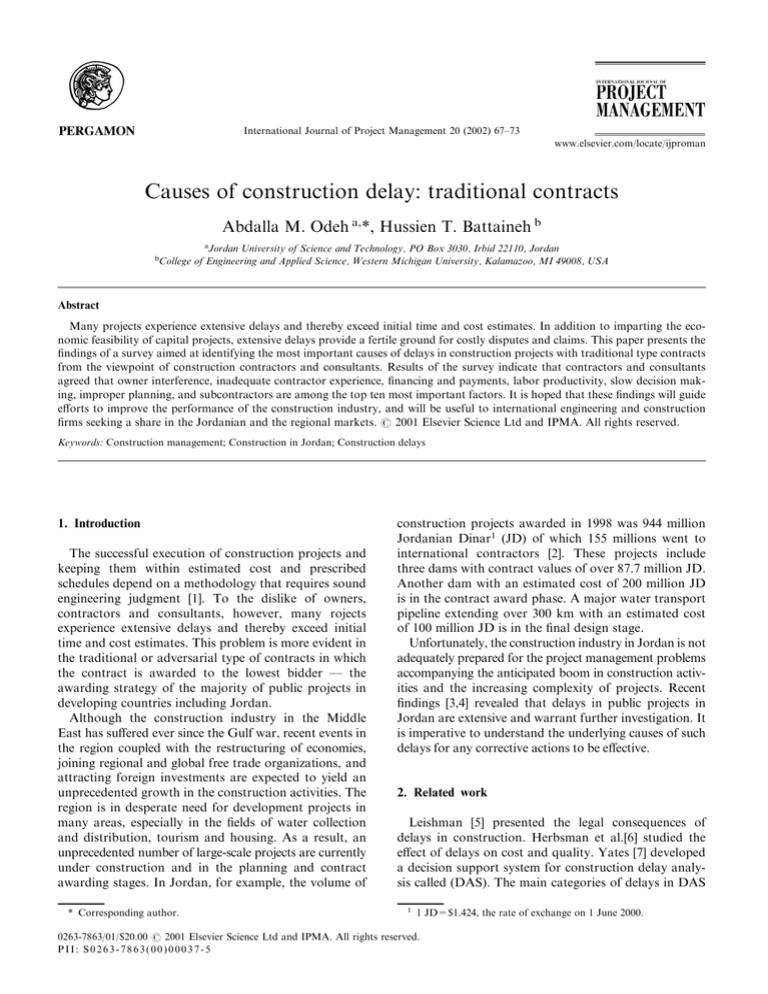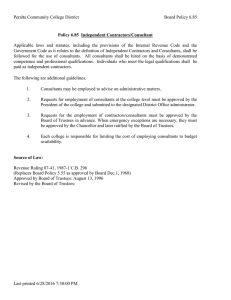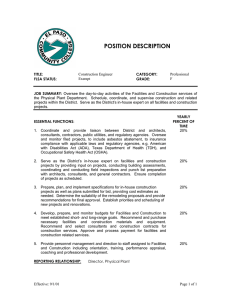
International Journal of Project Management 20 (2002) 67±73
www.elsevier.com/locate/ijproman
Causes of construction delay: traditional contracts
Abdalla M. Odeh a,*, Hussien T. Battaineh b
a
Jordan University of Science and Technology, PO Box 3030, Irbid 22110, Jordan
College of Engineering and Applied Science, Western Michigan University, Kalamazoo, MI 49008, USA
b
Abstract
Many projects experience extensive delays and thereby exceed initial time and cost estimates. In addition to imparting the economic feasibility of capital projects, extensive delays provide a fertile ground for costly disputes and claims. This paper presents the
®ndings of a survey aimed at identifying the most important causes of delays in construction projects with traditional type contracts
from the viewpoint of construction contractors and consultants. Results of the survey indicate that contractors and consultants
agreed that owner interference, inadequate contractor experience, ®nancing and payments, labor productivity, slow decision making, improper planning, and subcontractors are among the top ten most important factors. It is hoped that these ®ndings will guide
eorts to improve the performance of the construction industry, and will be useful to international engineering and construction
®rms seeking a share in the Jordanian and the regional markets. # 2001 Elsevier Science Ltd and IPMA. All rights reserved.
Keywords: Construction management; Construction in Jordan; Construction delays
1. Introduction
The successful execution of construction projects and
keeping them within estimated cost and prescribed
schedules depend on a methodology that requires sound
engineering judgment [1]. To the dislike of owners,
contractors and consultants, however, many rojects
experience extensive delays and thereby exceed initial
time and cost estimates. This problem is more evident in
the traditional or adversarial type of contracts in which
the contract is awarded to the lowest bidder Ð the
awarding strategy of the majority of public projects in
developing countries including Jordan.
Although the construction industry in the Middle
East has suered ever since the Gulf war, recent events in
the region coupled with the restructuring of economies,
joining regional and global free trade organizations, and
attracting foreign investments are expected to yield an
unprecedented growth in the construction activities. The
region is in desperate need for development projects in
many areas, especially in the ®elds of water collection
and distribution, tourism and housing. As a result, an
unprecedented number of large-scale projects are currently
under construction and in the planning and contract
awarding stages. In Jordan, for example, the volume of
* Corresponding author.
construction projects awarded in 1998 was 944 million
Jordanian Dinar1 (JD) of which 155 millions went to
international contractors [2]. These projects include
three dams with contract values of over 87.7 million JD.
Another dam with an estimated cost of 200 million JD
is in the contract award phase. A major water transport
pipeline extending over 300 km with an estimated cost
of 100 million JD is in the ®nal design stage.
Unfortunately, the construction industry in Jordan is not
adequately prepared for the project management problems
accompanying the anticipated boom in construction activities and the increasing complexity of projects. Recent
®ndings [3,4] revealed that delays in public projects in
Jordan are extensive and warrant further investigation. It
is imperative to understand the underlying causes of such
delays for any corrective actions to be eective.
2. Related work
Leishman [5] presented the legal consequences of
delays in construction. Herbsman et al.[6] studied the
eect of delays on cost and quality. Yates [7] developed
a decision support system for construction delay analysis called (DAS). The main categories of delays in DAS
1
1 JD=$1.424, the rate of exchange on 1 June 2000.
0263-7863/01/$20.00 # 2001 Elsevier Science Ltd and IPMA. All rights reserved.
PII: S0263-7863(00)00037-5
68
A.M. Odeh, H.T. Battaineh / International Journal of Project Management 20 (2002) 67±73
include engineering, equipment, external delays, labor,
management, material, owner, subcontractors, and
weather.
Ogunlana et al. [8] studied the delays in building project
in Thailand, as an example of developing economies. They
concluded that the problems of the construction industry
in developing economies can be nested in three layers:
(1) problem of shortages or inadequacies in industry
infrastructure, mainly supply of resources; (2) problems
caused by clients and consultants; and (3) problems
caused by incompetence of contractors. Kumaraswamy et
al. [9] surveyed the causes of construction delays in Hong
Kong as seen by clients, contractors and consultants, and
examined the factors aecting productivity. The survey
revealed dierences in perceptions of the relative signi®cance of factors between the three groups, indicative
of their experiences, possible prejudices and lack of
eective communication. Mans®eld et al. [10] studied
the causes of delay and cost overrun in construction
projects in Nigeria. The results showed that the most
important factors are ®nancing and payment for completed works, poor contract management, changes in site
conditions, shortage of material, and improper planing.
Assaf et al. [11] studied the causes of delay in large
building construction projects in Saudi Arabia. The
most important causes of delay included approval of
shop drawings, delays in payments to contractors and
the resulting cash problems during construction, design
changes, con¯icts in work schedules of subcontractors,
slow decision making and executive bureaucracy in the
owners' organizations, design errors, labor shortage and
inadequate labor skills. Mezher et al. [12] conducted a
survey of the causes of delays in the construction
industry in Lebanon from the viewpoint of owners,
contractors and architectural/engineering ®rms. It was
found that owners had more concerns with regard to
®nancial issues, contractors regarded contractual relationships the most important, while consultants considered
project management issues to be the most important
causes of delays.
Battaineh [3] evaluated the progress reports of 164
building and 28 highway projects constructed during the
period 1996±1999 in Jordan. The results indicate that
delays are extensive: the average ratio of actual completion time to the planned contract duration is 160.5%
for road projects and 120.3% for building projects.
Al-Momani [4] conducted a quantitative analysis of
construction delays by examining the records of 130
public building projects constructed in Jordan during
the period of 1990±1997. The researcher presented
regression models of the relationship between actual
and planned project duration for dierent types of
building facilities. The analysis also included the reported
frequencies of time extensions for the dierent causes of
delays. The researcher concluded that the main causes
of delay in construction projects relate to designers, user
changes, weather, site conditions, late deliveries, economic conditions, and increase in quantities. However,
such conclusion can be misleading. First, they included
causes which are limited to those for which contractors
are entitled to time extension. The analysis does not
cover causes of delay for which the contractor is
responsible, such as those related to labor and equipment,
planning and site management, construction methods,
adequacy and capability of contractor. Second, they are
based on the reported number of time extensions not on
the extent of delay attributed to the dierent causes of
delay. Despite the moderate weather in Jordan, for
example, it was ®gured among the major causes of delay
because a time extension was granted for all public
projects under construction in the winter of 1991 as a
result of an unprecedented severe storm that had a very
low probability of occurrence. Third, they are drawn
from records of public building projects and one would
question their validity to other types of construction
projects such as industrial facilities, water collection
treatment and distribution, and highway construction.
3. Research design and objectives
The objective of this research is to identify the major
causes of delay in the construction industry and to
assess the relative importance of these causes for the
traditional adversarial type of contracts from the viewpoint
of construction contractors and consultants. First, a survey
questionnaire was developed to assess the perceptions of
contractors and consultants of the relative importance of
construction delay causes. Second, the questionnaire
was distributed to a random sample of contractors and
consultants working on large projects in Jordan. Responses
to the questionnaire were then collected and analyzed.
The analysis included ranking the dierent causes
according to the relative importance indexes for both
contractors and consultants responses. The Spearman's
rank correlation coecient was then used to test association between the contractors and consultants ranking.
4. Causes of delay
The survey is based on 28 well recognized causes of
delay to which participants were asked to indicate their
level of importance of each cause. These causes were
categorized into the following 8 major groups:
1. Client related factors include ®nance and payments of completed work, owner interference, slow
decision making and unrealistic contract duration
imposed by owners.
2. Contractor related factors include site management, improper planning, inadequate contractor
A.M. Odeh, H.T. Battaineh / International Journal of Project Management 20 (2002) 67±73
3.
4.
5.
6.
7.
8.
experience, mistakes during construction, improper construction methods and delays caused by
subcontractors. Delays caused by subcontractors
are included among the contractor's factors
because the latter is fully responsible for the delays
caused by his subcontractors.
Consultant related factors include contract management, preparation and approval of drawings,
quality assurance/control, and long waiting time
for approval of tests and inspections.
Material factors include quality and shortage.
Labor and equipment factors include labor supply,
labor productivity, and equipment availability and
failure.
Contract factors include changed orders and mistakes and discrepancies in contract documents.
Contractual relationships factors include major
disputes and negotiations during construction,
inappropriate organizational structure linking all
parties involved in the project, and lack of communication between these parties.
External factors include weather conditions, changes in regulations, problems with neighbors and
site conditions.
Other signi®cant issues of concern such as political,
socio-economical and religious factors are dismissed
because it is felt that people in this part of the world are
very sensitive to these issues to a degree that might prejudice their responses.
5. Survey methodology
The scope of the research included large public and
private buildings, roads, and water and sewer projects in
Jordan. Given this scope, the questionnaire was distributed to a random sample of 100 contractors and 50
consultants representing the dierent specialization of
contractors and consultants working on large projects
(contract value>1 million JD). Tables 1 and 2 show the
distribution of the population, sample, and respondents
among the dierent specializations of contractors and
consultants classi®ed by the Ministry of Public Works
and Housing to take on large projects. The sample size
Table 1
Distribution of population, sample and respondents of the dierent
specializations of contractors
of each specialization is proportional to the distribution
of the population of the dierent specializations. Given
the sample size, the samples were selected randomly
from the population in each specialization.
The respondents were asked to express their perception of the relative importance of each of the 28 causes
of delays as either: extreme, very, moderate, slight, or
not important. The questionnaire was personally handed
over to respondents, and an interviewer was available to
answer questions about the questionnaire and to ensure
that the questionnaire is administered by VPs or project
managers. This mode of follow-up communication led
to the return of 82 completed questionnaires: 63 contractors and 19 consultants.
6. Analysis of responses
To determine the ranking of dierent causes from the
point of view of contractors and of consultants, the
relative importance index (I) was computed as:
5
P
I
Wi Xi
i1
5
P
Xi
i1
where:
i
=response category index=1, 2, 3, 4, and 5 for
not-, slightly-, moderately-, very-, and extremelyimportant, respectively.
Wi =the weight assigned to the ith response=0, 1, 2, 3,
4, respectively.
Xi =frequency of the ith response given as percentage
of the total responses for each cause.
The indexes were then ranked, and the results are
shown in Table 3. Calculating the average indexes of the
causes in each group gives the relative importance index
of the mean groups. The mean indexes and the ranking
of all groups are shown in Table 4. The Spearman's
correlation coecients of the ranking of contractors
and consultants for all the causes and for the main
Table 2
Distribution of population, sample and respondents of the dierent
specializations of consultants
Specialization of contractors
Population
Sample
Respondents
69
Specialization of consultants
Buildings
Roads
Water and sewer
Total
222
50
39
141
32
27
80
18
16
265
100
82
Population
Sample
Respondents
Buildings
Roads
Water and Sewer
Total
42
26
9
22
14
5
16
10
5
80
50
19
70
A.M. Odeh, H.T. Battaineh / International Journal of Project Management 20 (2002) 67±73
Table 3
Relative importance index and ranking of delay factors
Contractors
Consultants
Category
Factor
Index
Rank
Index
Rank
Client
Finance and payments of completed work
Owner interference
Slow decision-making by owners
Unrealistic imposed contract duration
3.30
3.51
3.24
3.08
4
2
8
13
3.32
3.21
3.16
3.11
2
4
5
6
Contractor
Subcontractors
Site management
Construction methods
Improper planning
Mistakes during construction
Inadequate contractor experience
3.21
3.29
3.29
3.14
2.56
3.37
9
5
5
10
17
3
3.26
2.58
2.37
2.95
2.74
3.37
3
13
17
8
11
1
Consultant
Contract management
Preparation and approval of drawings
Quality assurance/control
Waiting time for approval of tests and inspections
3.10
2.32
2.06
2.46
12
21
25
18
3.00
2.21
2.11
2.47
7
19
21
15
Material
Quality of material
Shortage in material
1.75
3.11
26
11
2.00
2.79
23
10
Labor and equipment
Labor supply
Labor productivity
Equipment availability and failure
2.63
3.60
3.25
16
1
7
2.63
2.89
2.42
12
9
16
Contract
Change orders
Mistakes and discrepancies in contract documents
2.40
3.05
19
14
1.79
2.05
26
22
Contractual relationships
Major disputes and negotiations
Inappropriate overall organizational structure linking all parties to the project
Lack of communication between the parties
2.94
2.27
2.38
15
22
20
2.16
2.26
2.53
20
18
14
External factors
Weather condition
Regulatory changes and building Code
Problems with neighbors
Unforeseen ground conditions
2.19
1.70
1.59
2.10
23
27
28
24
1.95
1.16
1.58
1.84
24
28
27
25
categories of delays are 0.789 and 0.762, respectively.
These correlation coecients are calculated for the
ranking shown in Tables 3 and 4 using the following
equation [13]:
P
6 d2
rS 1
N
N2 1
where:
rS =Spearman's rank correlation coecient.
d =the dierence in ranking between the contractors and
the consultants, and
N=the number of variables, equals to 28 and 8 for all the
causes and for the main categories of causes of delay,
respectively.
The somewhat high values of rank correlation coecients indicate strong agreement between contractors
and consultants on the ranking of all the factors and of
the main groups of factors. This association between the
ranking of contractors and consultants is veri®ed by a
hypothesis
p testing at 95% signi®cance where Z
rS N 1
Table 4
Importance index and ranking of major delay categories
Contractors
Consultants
Category
Index
Rank
Index
Rank
Client
Contractor
Consultant
Material
Labor and equipment
Contract
Contractual relationships
External factors
3.28
3.14
2.48
2.43
3.16
2.72
2.53
1.89
1
3
6
7
2
4
5
8
3.20
2.88
2.45
2.39
2.65
1.92
2.32
1.63
1
2
4
5
3
7
6
8
A.M. Odeh, H.T. Battaineh / International Journal of Project Management 20 (2002) 67±73
7. Discussion of results
The ranking of the relative importance of the delay
factors, Table 3, shows that owner interference, inadequate
contractor experience, and ®nancing and payments of
completed work made the top ®ve signi®cant factors for
both contractors and consultants. Moreover, labor productivity, site management, slow decision making, construction methods, improper planning and subcontractors
are among the top ten ranked factors of both groups.
The following is a brief discussion of the ranking of
the relative importance of the groups of delay factors, as
deducted from Tables 3 and 4.
7.1. Client
The client related group of delay factors was the most
important group to both contractors and consultants.
This is mainly due to ®nancing issues and owner interference, which are considered very important by both
parties. It was interesting to ®nd out that slow decision
by owners and unrealistic contract duration are of more
importance to consultants than to contractors. This is
because contractors considered operational issues, such
as labor productivity and equipment availability and
failure, of more importance. Unlike contractors, however,
consultants considered the client related factors to be
more important than operational ones.
7.2. Contractor
Both contractors and consultants ranked this group
of causes very high. It is worth noticing that consultants
are mainly concerned with technical factors such as inadequate contractors experience, delays caused by subcontractors, and improper planning, while contractors are
more concerned with managerial and operational factors
such as site management and construction methods.
Inadequate contractor experience was the most
important factor in this group. This can be attributed to
the contract awarding procedure where most projects
are awarded to the lowest bidder. Moreover, local contractors, solely or through joint ventures, are being
awarded large and complex projects in which they have
little experience because such projects were virtually
limited to international contractors in the past.
Delays caused by subcontractors are also of high
importance to consultants. This can be attributed to
inadequate experience of subcontractors, the bid shopping
practice of general contractors, and to improper planning and coordination.
Improper planning is also troublesome to contractors
and consultants. Local contractors are reluctant to use
scheduling techniques and to update schedules on a
regular basis. Despite the fact that contractors are
required to provide work schedules on most projects,
71
the schedule is often a summary schedule that is hardly
updated during construction. This is substantiated by the
fact that only 8 of the 63 sampled contractors responded
positively to updating schedules on their projects.
Delays caused by improper construction methods are
more important to contractors than to consultants.
Fluctuation in the construction market and the seasonal
nature of the industry has forced many contractors towards
diversity. As a result, they do not focus on one line-of-work
and try to adopt advanced methods and techniques.
Site management is another important cause of delay to
contractors. This is due to the reluctance of contractors to
invest in planning and control and to the lack of professional construction managers. The majority of site
managers are civil engineers with a good work experience but little training or education in management.
7.3. Consultants
Neither contractors nor consultants ranked this group of
factors high among the major groups of delay causing factors. Contrary to what is expected, consultants consistently
ranked each of these causes higher than contractors. The
highest ranked factor among these causes was contract
management. This could be attributed to the lack of
authority the owners are willing to delegate to consultants
enabling them to manage the contract eectively. This
®nding is consistent with the high ranking of owner
interference and the low ranking of factors over which the
consultants are usually granted authority. The latter factors
include preparation and approval of drawings, quality
assurance/control, and approval of tests and inspections.
7.4. Material
The group of material related causes received low
ranking by both contractors and consultants. Quality of
material was among the least important causes because
most of the available material is local with little variation
in quality, especially for cement, steel, and asphalt that
are produced by a limited number of producers. Shortage
of material received higher ranking than quality. This is
particularly true for imported material that may take a
considerable time to procure.
7.5. Labor and equipment
This group of causes were ranked high, second by
contractors and third by consultants. As expected, this
group of causes is more important to contractors than
to consultants. This was true for labor productivity and
for equipment availability and failure. While labor supply
is not that important considering the relatively inexpensive ¯ux of foreign and local laborers, the productivity of the labor forces was the top ranked factor
for contractors. This may be attributed to lack of
72
A.M. Odeh, H.T. Battaineh / International Journal of Project Management 20 (2002) 67±73
incentives for higher productivity, lack of or improper
training, and absence of trade unions or associations
that regulate, train, and classify construction trades.
The high ranking of contractors of equipment availability and failure indicate problems associated with
ownership of new equipment, maintenance and repair,
and availability and reliability of the rental option.
7.6. External factors
External factors were the lowest ranked group of factors
by both parties. It seems that all parties are familiar with
these factors and are able to deal with them eectively
without causing any major delays. Of course, the moderate weather conditions in Jordan coupled with low levels
of water tables in addition to well established regulations
and building code contribute to this low ranking.
7.7. Contract
This group of causes had more dierence in ranking
than any other group. While it was considered important
and ranked fourth by contractors, it was unimportant
and ranked only seventh by consultants. Contrary to
contractors, consultants who are usually empowered to
issue changed orders and to correct mistakes and discrepancies in contract documents are less critical of their
role in causing such delays.
7.8. Contractual relationships
This group of causes was ranked low by contractors and
consultants. Relatively, factors relating to organization
and communication were more important to consultants than to contractors. Delays caused by disputes
and negotiations were more important to contractors,
especially for public projects in Jordan where arbitration is not allowed and where legal recourse through
courts takes a considerable time.
availability and failure were more important to contractors than to consultants. Contractors were also
more concerned with factors related to contract clauses
that may alter their contractual obligations and rights.
These factors include changed orders, mistakes and
discrepancies in contract documents and major disputes
and negotiations. However, factors dealing with subcontracting, planning, organizing and communicating
were more important to consultants than to contractors.
Delays are costly and often result in disputes and
claims, impair the feasibility for project owners, and
retard the development of the construction industry. To
improve the situation, the ®ndings of this research must
be addressed by a joint eort of all participants in the
construction industry. This calls for:
1. Enforcing liquidated damage clauses and oering
incentives for early completion.
2. Developing human resources in the construction
industry through proper training and classifying of
craftsmen. This calls for providing incentives such as
oering a tax deduction on money spent on training,
and for authorizing trade unions or other agencies to
regulate, follow-up on training, and classify trades.
Developing human resources also applies to construction engineers who usually lack adequate managerial
skills. There is an urgent need for oering training
courses in scheduling, time and cost control, information systems, and management of human resources.
3. Adopting a new approach to contract award procedure by giving less weight to prices and more
weight to the capabilities and past performance of
contractors.
4. Adopting new approaches to contracting, such as
design-build and construction management (CM)
types of contracts. Such contracts reduce delays by
limiting owner interference, improving the design,
and improving the contractual relationships
among all parties to the project.
References
8. Conclusions and recommendations
According to contractors, labor productivity was the
most important delay factor. Inadequate contractor
experience, however, was the most important delay factor
to consultants. All parties generally agreed on the ranking
of the individual delay factors. They agreed that inadequate contractor experience, owner interference, and
®nancing of work were among the top ®ve most important
factors. Moreover, delays caused by subcontractors, slow
decision making by owners, improper planning, and
labor productivity were among the top ten most important factors for both parties.
Operational factors such as labor productivity, construction methods, site management, and equipment
[1] Hancher DE, Rowings IE. Setting highway construction contract
duration. Journal of Construction Engineering and Management,
ASCE 1981;107(2):169±79.
[2] Department of public contracts. The Annual book, the Ministry
of Public Works and Housing, Jordan, 1998.
[3] Battaineh HT. Information system of progress evaluation of
public projects in Jordan, MSc thesis, Dept. of Civil Engineering,
Jordan Univ. of Science and Technology, Irbid, Jordan, 1999.
[4] Al-Moumani HA. Construction delay:a quantitative analysis.
International Journal of Project Management 2000;18:51±9.
[5] Leishman DM. Protecting engineer against construction delay claims:
NDC. Journal of Management in Engineering 1991;7(3):319±33.
[6] Herbsman ZJ, Chen WT, Epstein WC. Time is money:innovative
contracting methods in highway construction. Journal of Construction Engineering and Management, ASCE 1995;121(3):273±81.
[7] Yates J. Construction decision support system for delay analysis.
Journal of Construction Engineering and Management, ASCE
1993;119(2):226±44.
A.M. Odeh, H.T. Battaineh / International Journal of Project Management 20 (2002) 67±73
[8] Ogunlana SO, Promkuntong K. Construction delays in a fastgrowing economy: comparing Thailand with other economies.
International Journal of Project Management 1996;14(1):37±45.
[9] Kumaraswamy MM ChanWM. Contributors to construction
delays. Construction Management and Economics 1998;16:17±29.
[10] Mans®eld NR, Ugwu OO, Doran T. Causes of delay and cost
overruns in Nigerian construction projects. International Journal
of Project Management 1994;12(4):254±60.
73
[11] Assaf SA, Al-Khalil M, Al-Hazmi M. Causes of delay in large
building construction projects. Journal of Management in Engineering ASCE 1995;11(2):45±50.
[12] Mezher TM, Tawil W. Causes of delays in the construction
industry in Lebanon. Engineering Construction and Architectural Management Journal 1998;5(3):251±60.
[13] Dowdy S, Wearden S. Statistics for research. 2nd Ed. New York:
John Wiley & Sons, 1985.







